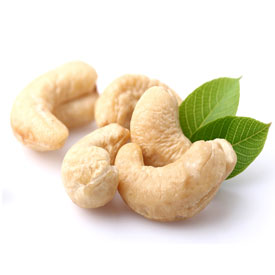
The cashew tree is related to the mango, pistachio and poison ivy plants. The tree is native to South America, mainly found in Brazil and Peru. In the sixteenth century, Portuguese traders introduced the tree to India where it was originally grown to prevent erosion. The flavor virtues of the cashew nut were realized quite late in history, because the nut contains a caustic oil, called cardol, which makes the nuts inedible. It was not until 1920’s, when the shelling process was perfected to remove the cardol from the nut with the result being the crunchy cashew we enjoy today.
Cashews are produced in 32 countries, and the World’s consumption of cashews is a bout 4.1 billion lbs annually. The United States is the largest importer of cashew nuts. Cashews are the #1 nut crop in the world.
Many people mistakenly avoid cashews because of their high fat content, though they are lower in total fat than almonds, peanuts, pecans, and walnuts. While 47 % of the total weight of the cashew is fat, it is what is often referred to as the “good” fat. In fact, approximately 75% of their fat is unsaturated, and most of that is oleic acid, the same heart-healthy fat found in olive oil. Studies show that oleic acid promotes good cardiovascular health.
In addition to their healthful fats, cashews are very good sources of copper and magnesium. Copper is essential for energy production and maintenance of bones and blood vessels. Numerous health problems can develop when copper intake is inadequate, including iron deficiency anemia, osteoporosis, joint problems such as rheumatoid arthritis and many others.
We hear a lot about the importance of calcium for healthy bones, but magnesium is also vital for healthy bones. About two-thirds of the magnesium in the human body is found in our bones. Magnesium, helps regulate nerve and muscle tone. Insufficient magnesium can contribute to high blood pressure, muscle spasms, and migraine headaches. Studies have shown magnesium helps reduce the frequency of migraine attacks, lowers blood pressure, helps prevent heart attacks, and reduces the severity of asthma.
Besides tasting great, cashews can provide many nutrients to keep you and your family healthy. On your next visit to the supermarket, add some cashews to the shopping cart!
Age to introduce: Over 12 months old, finely ground. Whole or pieces of cashews and cashew butter (similar to peanut butter) are choking hazards until a child is 2-3 years old.
CAUTION: Cashews are a nut, and they are considered a high allergen.
Toddler Treat: Maple Carrots and Cashews
Baby carrots are very toddler-friendly and most children love cashews. We’ve teamed up these two great tastes in a simple side dish that will appeal to both the young and old.
Ingredients:
- 1 pound baby carrots
- 1 cup chicken/vegetable broth
- 2 Tbsp butter
- 1 Tbsp maple syrup
- 2 Tbsp chopped cashews
Directions:
In a saucepan bring the chicken (or vegetable) broth to a boil. Add the baby carrots and return to a boil. Reduce heat to low and simmer for 3 minutes. Remove from heat and pour carrots and broth into a colander to drain. With the saucepan still hot, add butter and honey and stir unit melted. Add the carrots and toss gently. Transfer carrots to a serving dish and sprinkle the carrots with chopped cashews.
Cashews For The Family
At the market: Cashews are not sold in the shell. They are available raw or roasted in the nut section or bulk food aisle of a supermarket. Cashews are sold whole (expensive) or in pieces (less expensive). They are highly perishable and can turn rancid quickly due to their high oil content. Choose vacuum-packed jars or cans over cellophane packaging. If you are buying in the bulk aisle, make sure there is a high turnover of foods in this section to ensure maximum freshness.
Storage: Store cashews in an airtight container. At room temperature, they will not keep fresh long. It is best to refrigerate them, and they’ll last up to six months. Cashews may also be frozen up to one year.
Cooking tips:
- For hot dishes, add cashews at the end of the cooking process (or just before serving) as they quickly become soft and will disintegrate when cooked.
- Cashews soften in baked goods and do not stay crunchy like other nuts.
Ideas for adding cashews into your family meals:
Sprinkle a handful on chopped cashews on:
- Green salads
- Pancakes or waffles with maple syrup
- Your favorite Chinese take out
- Breakfast cereals (hot or cold)
- Fresh fruit salads
Quick Indian Rice: Just before serving, add ¼ cup chopped cashews, ¼ cup raisins, and 1 Tbsp chopped green onions to cooked basmati (or brown) rice.
Curried Chicken Salad: Toss 1 Tbsp chopped cashews, ¼ cup diced mango or pineapple, 2-3 Tbsp mayonnaise, and 1 teaspoon of curry powder with 2 cups of diced, cooked chicken. Serve on toasted English muffins.
Homemade Cashew Butter: Cashew butter is fun (and simple) to make with your children. Cashew butter is very similar to peanut butter – it just tastes much better. For best results, you will need a food processor with a standard metal “s” shape blade. A blender can also be used.
- 2 cups roasted (unsalted) cashews pieces
- 2 – 3 Tablespoons vegetable oil or butter
- Pinch of salt
Directions: Combine the cashews, 2 Tablespoons of oil (or butter), and salt in the food processor. Process for 30 seconds, stop the machine and scrape the sides down. Continue to process and scrape down the sides until the cashews butter is a smooth, creamy consistency. If the cashew butter is to pasty, it may be necessary to add a little more oil. Add oil, one teaspoon at time, down the spout while the machine in on until the texture turns smooth.
Transfer the cashew butter to a jar that seals tightly. Refrigerate. Cashew butter is an unprocessed food, and the oil and solids sometimes separate in the jar. If this happens, simply stir together before using it. For a spreadable consistency, warm the cashew butter to room temperature.
Banana Cashew Milk Shake
Ingredients:
- ½ banana, peeled
- 2 Tbsp cashew butter
- 1 scoop vanilla frozen yogurt
- 1 cup milk (soy or dairy)
Directions: Place all ingredients in a blender and process until smooth. Pour into glasses and enjoy. Make 2 servings.


